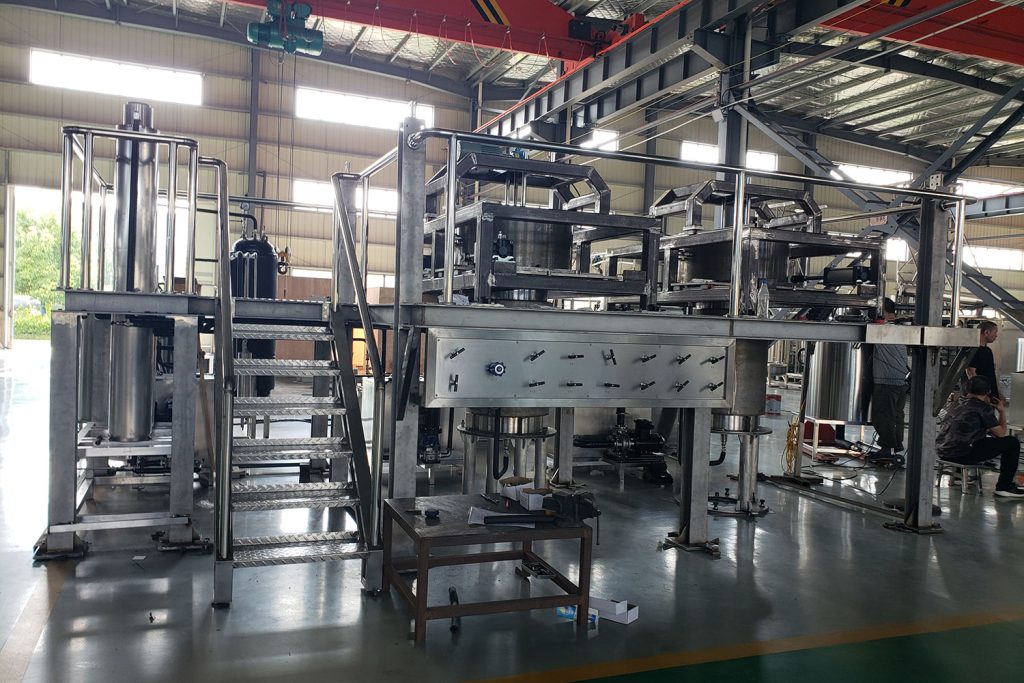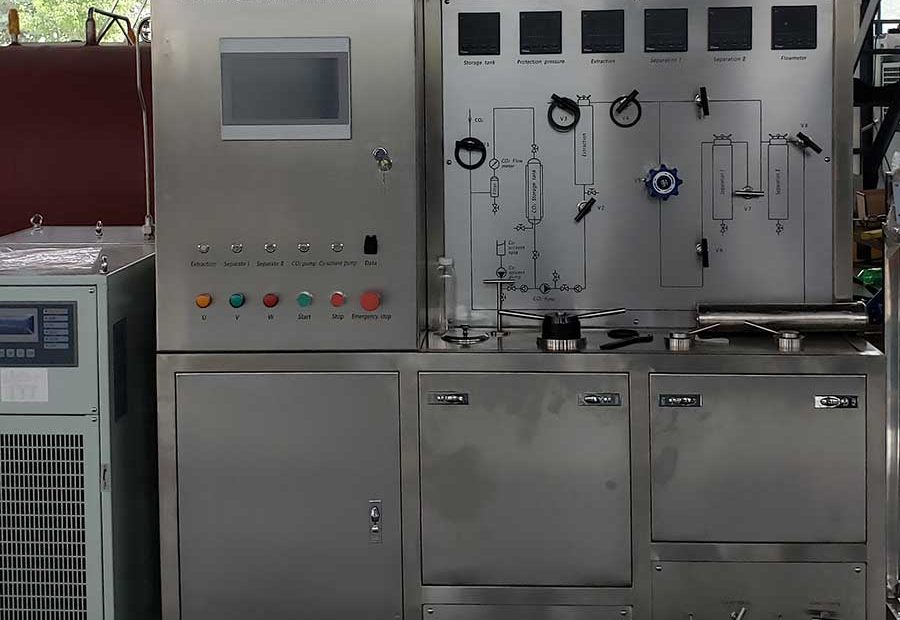Depending on the temperature and pressure, the substance presents state changes such as liquid, gas, and solid. Gas molecules have the greatest kinetic energy and the greatest penetration. When the temperature drops and the pressure rises, the gas will condense into liquid, and the liquid molecules The distance between them is greatly reduced, and the density and solubility are obviously increased.
For a specific substance, when it is in the state above its critical temperature and critical pressure, if pressure is applied to the gas in this state, the gas will not be liquefied, but its density will increase, and it will have properties similar to liquid state, while retaining the properties of gas. This state of fluid is called supercritical fluid.
Supercritical CO2 extraction that can be used as extraction solvents and reactive fluids must be selected according to their respective characteristics and adaptability.
Physical properties of supercritical fluid CO2 extraction machine
Density
Under normal temperature and pressure, the density of liquid is 0.6~1.6g/cm³, and the density of supercritical fluid is 0.2~0.5g/cm³. It can be seen that supercritical fluid has a density close to that of liquid. But the density of the two has different dependence on temperature and pressure. This is due to the compressibility of supercritical fluid, so compared with normal liquid, its density has a greater correlation with temperature and pressure. For example: at 400 ℃, the pressure changes in the range of 0.22~2.5kPa, and the density of water can be reduced from 0.1g/cm³ to 0.84g/cm³.
Viscosity
In the standard state, the viscosity of liquid is 0.2 ~ 0.3Pa.s, the viscosity of gas is 0.01 ~ 0.03Pa.s, the viscosity of SCF is 0.01 ~ 0.03Pa.s, it can be seen that the viscosity of SCF is close to that of gas. Temperature and density are the main factors affecting viscosity. Both the collision between molecules and the collision during free translation of molecules can cause momentum transfer, and the combined effect of momentum transfer caused by these two collisions can reflect the fluid viscosity. The temperature and density will affect the momentum transfer mode, thereby changing the fluid viscosity. SCF and liquid viscosity are different in changing rules affected by temperature and density. Generally, the viscosity of the liquid decreases with the increase of temperature; under the condition of high density of SCF, the viscosity decreases with the increase of temperature; under the condition of low density, the result is opposite. Zabaloyt used the molecular simulation results of LJ-fluid to build a model and establish a viscosity expression suitable for supercritical fluid.
Diffusion coefficient
The diffusion coefficient of SCF is between gas and liquid, 10~100 times that of liquid at room temperature. The diffusion coefficient is pressure and temperature dependent. However, the variation law and expression of the diffusion coefficient of normal fluid and SCF are different. Generally, the diffusion coefficient of a normal fluid increases with the pressure drop and is inversely proportional to the viscosity. The diffusion coefficient can be estimated according to the Stokes-Einstein relationship. The diffusion coefficient of SCF increases with pressure. When the density is very high, the S-E relationship can be used, and it is known that a small pressure change can cause a large change in the diffusion coefficient, and the diffusion coefficient is inversely proportional to the viscosity.
Surface tension
General liquids have surface tension, but the surface tension of each fluid is approximately 0 in the supercritical state. This is because in the non-supercritical state, as the system approaches the critical point, the fluid two-phase interface gradually thickens and diffuses each other; when the critical point is reached, the two fluids will lose their respective characteristics and become homogeneous; when the system reaches the supercritical state, As the degree of interfacial diffusion increases, the interfacial tension gradually decreases until it disappears completely. According to the experiment, as the two-phase temperature T in equilibrium reaches the critical temperature Tc, the interface thickness tends to 0 (C=0.61~0.67) according to the C power of (Tc~T), and the interfacial tension R according to (Tc~T) The L power tends to 0 (L=1.22~1.34).
Dielectric constant
The dielectric constant of supercritical fluid is different from that of normal fluid. For example, the dielectric constant of methanol is 32.6 in the standard state, while in the supercritical state (such as 250°C, 20Mpa), its dielectric constant drops to 7.2. The change of dielectric constant is related to density and temperature, it increases with the increase of density and decreases with the increase of temperature. And affected by the number of hydrogen bonds. For example, water has strong hydrogen bonds under normal conditions, so the dielectric constant is relatively large. As the temperature and pressure increase, the number of hydrogen bonds decreases, resulting in a significant decrease in the dielectric constant.

Solubility properties
Supercritical fluids have different solubility for different solutes under different temperature and pressure conditions. The solubility of supercritical fluid is related to its polarity and dielectric constant, so the solubility of supercritical fluid is significantly different from that of normal liquid. Generally, the supercritical temperature and pressure conditions close to the liquid density state are adopted, and its solubility is the highest, which is about 100 times that of the normal temperature and pressure conditions.
Compared with its normal state, the number of hydrogen bonds in supercritical methanol is reduced from 1.93 to less than 0.7, and the dielectric constant is also reduced, so its solubility has the following changes: at normal temperature and pressure, methanol and oil are incompatible with each other; in supercritical state , Methanol and oil are completely miscible. In addition, the supercritical state solubility of polar solvents and non-polar solvents is selective for solutes. For example, supercritical CO2 solvents are non-polar when used alone, and generally have good solubility for fat-soluble substances with small molecular weights. The properties of the supercritical fluid can be improved by adding other solvents, namely entrainers, such as macromolecular polar solutes, which can dissolve the solutes when the CO2 fluid is injected into the polar solvent that entrains ethanol at the same time.
Selectivity
Supercritical fluid has the characteristic of selectively extracting different substances. There are often more than two different compound components in the same plant. Generally, a certain component is extracted separately, which requires selective extraction. Supercritical fluid can complete the separate separation of different components under different conditions such as temperature, pressure, and entrainer. extract.
Different types of solvents have selectivity for solutes with different properties: esters, ethers, and ketones are suitable for extraction with non-polar solvents; solutes such as glycosides, alkalis, and sugars are suitable for extraction with polar solvents. Supercritical CO2 cannot extract water at room temperature, but when the temperature rises, the solubility increases and water can be extracted. When solutes have significant differences in molecular weight, vapor pressure, and polarity, fractional extraction can be performed.
Thermal conductivity
Near the critical point, the thermal conductivity of a substance is very sensitive to changes in temperature and pressure. Under supercritical conditions, if the pressure is constant, as the temperature increases, the thermal conductivity first decreases to a minimum value and then increases; if the temperature is constant, the thermal conductivity increases as the pressure increases.
For convective heat transfer, including forced convection and natural convection, natural convection is easy to occur when the temperature and pressure are high. For example, when supercritical CO2 is at 38°C, only a temperature difference of 3°C can cause natural convection.
Conclusion
The supercritical CO2 extraction process presents a realm of opportunities for various industries, but its high operating pressure mandates a robust safety framework. From production and maintenance to explosion and fire protection, each facet demands unwavering attention to detail.
